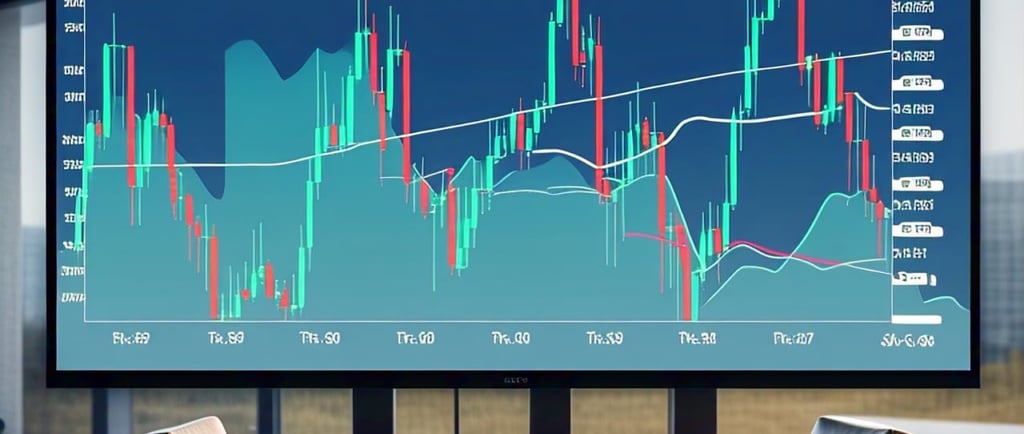Market Turmoil: Nasdaq Enters Bear Market and Dow in Correction as Traders Await Fed Chair Powell's Remarks
April 4, 2025 Nasdaq 100 Enters Bear Market, Dow In Correction Territory, Traders Await Fed Chair Powell's Remarks by Fadel Rah
TECHNOLOGY & CRYPTO
4/4/20257 min read


Introduction to Market Conditions
As of April 4, 2025, the financial landscape has been severely impacted, leading to notable turmoil across major indexes, particularly the Nasdaq 100 and the Dow Jones Industrial Average. The Nasdaq has officially entered bear market territory, characterized by a sharp decline of over 20 percent from its previous peak. This downturn represents a significant shift in market conditions, raising various concerns among investors and analysts alike. Meanwhile, the Dow Jones has also experienced a correction, defined as a drop of 10 percent or more from its recent highs, further emphasizing the pervasive uncertainty affecting the market.
The recent job reports have contributed to this unsettling environment, revealing weaker-than-expected employment growth and casting doubt on the overall economic recovery. Market participants are increasingly anxious, given that labor market stability often serves as a barometer for consumer spending and overall economic health. With job creation lagging behind expectations, the potential for a slowdown in economic activity raises alarms about future corporate earnings, consequently weighing heavily on stock valuations.
Additionally, fears stemming from an ongoing trade war between major economic powers have compounded the prevailing market woes. Such geopolitical tensions can disrupt trade flows, posing inflationary pressures and overall economic instability. Investors are now more cautious, contemplating the implications of these trade disputes on market dynamics in the coming months.
As traders keep a close watch on upcoming remarks from Fed Chair Jerome Powell, market sentiment remains tenuous. His comments are anticipated to shed light on the Federal Reserve's monetary policy direction, particularly in light of the prevailing economic conditions. This provides a critical context for understanding the volatility currently experienced in the markets and the potential direction as investors position themselves amid increasing uncertainty.
Impact of the March Jobs Report
The March jobs report revealed a significant addition of 228,000 new jobs, indicating a resilient performance in the U.S. labor market. This robust job creation reflects a strong demand for labor, suggesting that businesses are confident in their ability to grow and sustain their operations. Notably, the sectors contributing to this growth include hospitality, healthcare, and professional services, showcasing an overall diverse expansion. However, despite this promising data, the stock market is currently experiencing pronounced turbulence, with the Nasdaq entering bear market territory and the Dow Jones Industrial Average facing a correction.
The contrast between the thriving labor market and the troubling stock trends raises important questions about underlying economic dynamics. Economic resilience can often be assessed through various indicators, and while the job figures showcase a healthy demand for workers, other economic signals, such as inflationary pressures and Federal Reserve policies, may contribute to market unease. Recent projections have indicated inflation rates that continue to exceed the Federal Reserve's target. This situation suggests that despite job gains, workers face the challenge of rising living costs, which can dampen consumer spending and overall economic growth.
Understanding Bear Markets and Corrections
Bear markets and corrections are integral concepts in the realm of finance, particularly for investors navigating the often volatile landscape of stock markets. A bear market is typically defined as a decline of 20% or more from recent highs in stock indices or prices, whereas a correction signifies a more moderate downturn, usually ranging from 10% to 20%. Both phenomena are symptomatic of broader economic trends and investor sentiment, which can reflect increased anxiety, pessimism, or uncertainty within the market.
The recent entry of the Nasdaq into bear market territory serves as a clear illustration of these dynamics. Traders observed a significant decline from previous peak levels, driven by a confluence of economic factors such as rising interest rates, inflation pressures, and geopolitical tensions. The Nasdaq's decline was not merely a momentary fluctuation; it presented a substantial shift in market confidence and proffered an opportunity for investors to reassess their strategies in light of changing market conditions.
In parallel, the Dow Jones Industrial Average found itself in correction territory, falling between the critical thresholds that define this phase. The technical conditions leading to both the Nasdaq's bear market and the Dow's correction include a range of indicators such as moving averages, market breadth, and shifting trading volumes. The implications of such downturns often provoke a reassessment among investors regarding asset allocations, risk tolerance, and long-term objectives. Understanding these market conditions is crucial for making informed decisions that go beyond immediate emotional reactions to market declines.
Overall, while bear markets and corrections can induce distress among investors, they also present opportunities for strategic investment, underscoring the importance of maintaining a comprehensive understanding of the stock market's inherent cycles.
The Role of Trade War Fears
The recent market turmoil, particularly the bear market witnessed by the Nasdaq and the correction in the Dow, can be significantly attributed to the escalating fears stemming from trade tensions. Trade wars have the potential to disrupt economic stability, and recent developments have intensified these anxieties among traders. For instance, remarks by high-profile officials regarding tariffs and trade negotiations can send shockwaves through financial markets, leading to increased volatility. When trade dispute rhetoric intensifies, it creates an unpredictable environment that often overshadows positive economic indicators.
Traders are particularly sensitive to news related to tariffs and trade agreements as they can have a profound impact on the earnings outlook for many companies. Even strong economic data, such as solid employment figures or robust GDP growth, can be quickly overshadowed by fears of a trade war. This phenomenon is often observed when markets react negatively to any perceived escalation in trade tensions, regardless of the underlying economic fundamentals. The manner in which traders react to these developments illustrates the heightened level of uncertainty that characterizes current financial markets.
Moreover, the situation is further complicated by the ongoing geopolitical climate, which can act as a catalyst for trade fears to manifest more prominently. Statements from trade partners or indications of retaliatory measures can trigger a rapid response from traders, leading to pronounced fluctuations in stock prices. Consequently, the interplay between trade war fears and market performance has become a crucial area of focus for investors. As Wall Street grapples with these heightened tensions, the outlook remains closely tied to any developments related to trade policies, with an emphasis on remaining alert to shifts that may influence market sentiment.
Current Trading Sentiments and Risks
As market fluctuations continue, trading sentiments among investors and analysts reveal a cautious approach amidst the present turmoil. The recent downturn in major indices, particularly the Nasdaq entering bear market territory and the Dow experiencing a correction, has led to a palpable hesitance in the stock market. This sentiment is exacerbated by the absence of dip-buying activities, which historically indicate a potential rebound opportunity for investors. Without this buying momentum, many analysts speculate that the path to market recovery may be steeper and more prolonged.
The reluctance to engage in dip-buying reveals critical insights into trader psychology. Many investors appear to be adopting a wait-and-see attitude, which may stem from fears regarding the macroeconomic landscape, particularly the looming remarks from Fed Chair Jerome Powell. Analysts indicate that any guidance on future monetary policy could significantly affect trading decisions, as market participants assess potential interest rate hikes and their ramifications for economic growth. Additionally, uncertainty surrounding corporate earnings and inflation challenges adds to the prevailing risk sentiment.
Further complicating the trading environment is the perception of escalating risks. Many traders express concerns over geopolitical tensions, supply chain disruptions, and energy prices—all factors that contribute to market volatility. Institutions and individual investors alike are reevaluating their strategies, often opting for a more defensive posture in their portfolios. Opportunities for sector rotation into more stable industries, such as utilities or consumer staples, have gained attention as risk aversion grows. The cautious outlook underscores the necessity for vigilance in navigating this unpredictable market landscape, as sentiment continues to evolve in real-time.
Looking Ahead: Waiting for Powell's Remarks
The financial markets are poised on the edge of uncertainty as traders eagerly await Federal Reserve Chair Jerome Powell's upcoming remarks. Expectations surrounding his speech are particularly high, considering the recent market turbulence characterized by the Nasdaq entering a bear market and the Dow Jones Industrial Average facing a correction. The remarks will likely address crucial topics, including interest rates, inflation, and the overall economic outlook.
Traders are particularly concerned about how Powell's statements may impact market sentiment, especially with inflation rates continuing to exert pressure on the economy. Discussions around potential interest rate hikes have created a sense of anxiety among investors who are keenly aware that any signal from the Fed could either stifle or catalyze market movements. The expectation is that Powell will provide clarity on the Federal Reserve's strategy regarding monetary policy, which is essential in navigating the current economic landscape.
In recent months, inflation has remained stubbornly high, and the Fed's role in managing it is critical. Traders are expected to analyze Powell's language closely for any indications of future policy shifts, particularly regarding balancing inflation control with ongoing economic growth. Moreover, expectations related to employment figures and consumer spending will also be under scrutiny. A shift towards a more hawkish stance could lead to further declines in the stock market, while a dovish approach may bring some relief.
While the anticipation of Powell's remarks drives market speculation, it is important to recognize the broader economic context in which these discussions are taking place. The intersection of fiscal policy decisions and their implications for market dynamics illustrates the pivotal role of the Fed in shaping investor behavior. As the market waits for this critical communication, all eyes will remain focused on how Powell articulates the balance between controlling inflation and sustaining economic momentum.
Conclusion: Navigating Uncertain Times
In the current economic climate, characterized by significant market turmoil with the Nasdaq entering bear market territory and the Dow experiencing a correction, investors and traders alike find themselves facing unprecedented challenges. The fluctuations in the market underscore the uncertainty prevalent in the financial landscape, compounded by the ongoing anticipation of remarks from key figures such as Fed Chair Powell. These conditions necessitate a careful and informed approach to investing.
To successfully navigate through these turbulent times, it is imperative for investors to remain informed about market developments and macroeconomic indicators. Frequent monitoring of market trends and understanding the underlying factors influencing them can provide crucial insights. Staying updated with news related to Federal Reserve policies, interest rates, and economic data releases is essential, as such information can greatly impact market behavior. Furthermore, engaging with expert analyses and forecasts can offer additional perspectives, allowing traders to make informed decisions.
Adapting investment strategies is equally critical in volatile markets. Diversification across various asset classes can help mitigate risk, as relying solely on a single investment type can lead to substantial losses during downturns. The inclusion of defensive stocks or sectors that historically perform well during recessions may be beneficial. Additionally, maintaining a long-term perspective can assist traders in weathering the storms of short-term volatility, emphasizing the significance of patience and resilience.
In essence, while the current state of the markets may induce fear and uncertainty, adopting a proactive and informed investment strategy can help mitigate risks. By staying informed, adapting approaches, and maintaining a long-term outlook, traders and investors can navigate through these uncertain times with greater confidence.
